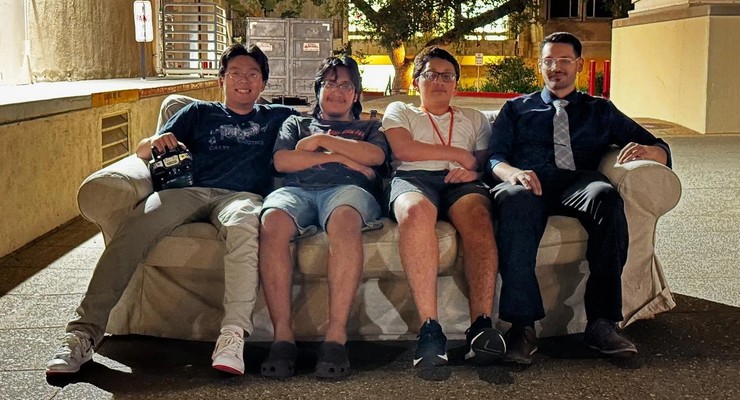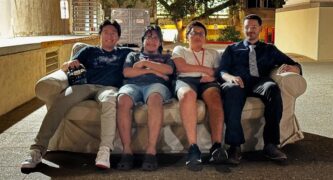
It started, as many great student projects do, with a determination to outdo a rival.
Undergraduate Donny Lu and other members of the Caltech Robotics Club had heard about a project in which engineering students at Stanford had affixed two electric skateboards to the bottom of a sofa, just to see if they could. The Techer team including students Myu Kim, Frank Gomez-Montalvo, and Luis Yael Serrano Laguna knew they could build a better, faster, more maneuverable piece of self-propelled furniture. And just a few weeks later — after a visit to a hardware store for lumber, the acquisition of some electric motors and wheels online, and twice-weekly meetings to make the machine work — their moveable beast rolled past Caltech’s Red Door Cafe.
The first step toward building a robo-couch is, well, the acquisition of a couch. A university sounds like an ideal place to source some not-so-gently used furniture. But after days spent scouring the online Caltech Marketplace, where students and staff buy and sell items, they came up empty. Lu says the process proved especially difficult because they needed a sofa that was on the smaller side; couches are already heavy and difficult to move around, and that problem is compounded when a human being or two climbs aboard.
The solution turned out to be right underneath them: The club’s own old brown couch, languishing in the basement of the Guggenheim Aeronautical Laboratory. The sofa fit the bill, and the members soon began plotting how to transform it into a mode of transportation.
The robo-couch they crafted sits on two wheels like those used on electric scooters that are connected to an electric motor, plus two other unmotorized wheels that simply work to share the couch’s weight. A rechargeable battery supplies the power.
At first, the club members wanted to break the world record for fastest couch by going 70-plus miles per hour. But then they considered the inherent dangers of breaking the speed limit on a piece of furniture. So, couch 1.0 putters around campus at a genteel 10 miles per hour, tops. Seatbelts are coming soon. Lu says the team drove for an hour on the maiden voyage and did not deplete the on-board battery.
Still, building a working motorized sofa is not as simple as slapping a couple of wheels on a couch. The torque created by the electric wheels exerts a great deal of force; early on, after some components broke during a trial run, the team enlisted the help of recent alum Maxx Ibarra (BS ’25), who works in robotics education with students in grades 6–12 and as lead mechanical engineer at robotics firm Rotender. He quickly designed and machined a custom coupler to connect the wheel parts. A particular challenge was the fact that each of the two motorized wheels works independently; Lu and company had to carefully tweak the control to ensure one motor did not accelerate slightly faster than the other and force the couch to drive sideways.
Not content to rest on their cushiony laurels, the Robotics Club members are now tweaking their creation. One possible next step is to develop a self-driving sofa that could find its own way around by using lidar to map the campus. On the advice of a colleague in PARSEC (Propulsion, Aeronautics, and Rocket Systems Engineering at Caltech), the builders have considered trying to let the future autonomous couch navigate by GPS.
These efforts might even lead to the world’s first sofa-share service. “Our goal is to make the couch even more unique,” Lu says. “We want to make this to take you from your dorm to your class autonomously.”


















